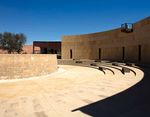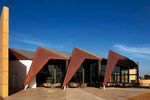STORIA E NATURA NEL DESERTO - HISTORY AND NATURE IN THE DESERT - Dabbagh Architects
←
→
Trascrizione del contenuto della pagina
Se il tuo browser non visualizza correttamente la pagina, ti preghiamo di leggere il contenuto della pagina quaggiù
STORIA E NATURA NEL DESERTO HISTORY AND NATURE IN THE DESERT L’architettura si esprime attraverso tre Architecture is expressed through elementi: quello delle forme e della three elements: the one of shapes and solidità, quello del vuoto, dello spazio solidity, the one of void, space and e della luce e quello, più impalpabile, light and the one, more intangible, dell’esperienza di chi la vive. Partendo of the experience of those who live da questo dogma, l’architetto it. Starting from this dogma, architect Sumaya Dabbagh, fondatrice dello Sumaya Dabbagh, founder of the studio Dabbagh Architects di Dubai, Dubai-based architectural practice ha affrontato il delicato progetto Dabbagh Architects, designed the del nuovo Centro di 2.000 mq del new 2,000 sqm Mleiha Archeological sito archeologico di Mleiha, situato Centre, located in the Emirate of nell’Emirato di Sharjah, il terzo per Sharjah, the third largest of the seven grandezza dei sette che compongono emirates in the United Arab Emirates. gli Emirati Arabi Uniti. Il progetto - che The project - which is part of a large rientra in un più ampio masterplan e masterplan and Eco Tourism project programma di ecoturismo promosso undertaken by the Sharjah Investment dall’Autorità per gli Investimenti and Development Authority - was e lo Sviluppo di Sharjah - è stato commissioned in 2013 out of the commissionato nel 2013 per volontà desire of the Ruler of the emirate del Sovrano dell’emirato con l’obiettivo with the aim to create a sustainable di realizzare un centro educativo educational centre, capable to preserve ecosostenibile, capace di preservare and showcase the wealth of the e mostrare l’importanza del ricco e secular archeological and natural secolare patrimonio archeologico e heritage of the region. Situated inside floro-faunistico della regione. Collocato one of the most important pre-Islamic all’interno di uno dei più importanti siti archeological sites of the region, archeologici preislamici della regione, inhabited by native wildlife species abitato da specie autoctone selvatiche such as the Arabian Oryx or the rhim quali l’orice d’Arabia e la gazzella gazelle, the centre, completed in 2016, bianca, la costruzione, realizzata nel is built around an ancient Bronze Age 2016, si sviluppa attorno a un’antica circular Tomb, 13.85 m in diameter, of tomba circolare del diametro di 13,85 the Umm al-Nar culture. m della civiltà Umm al-Nar, risalente all’Età del Bronzo. Mia Debs 56 57
Lo studio di architettura Dabbagh Architects ha progettato una costruzione sinuosa, che si snoda attorno all’antica tomba Umm al-Nar, cuore del progetto, con un ampio muro in arenaria, che guida i visitatori verso un cortiletto, al cui centro sorge un albero di Ghaf, elegante e malinconico simbolo della natura locale, che precede l’ingresso alla mostra. Il percorso espositivo, dedicato alla storia della tomba e alla comprensione del patrimonio storico e naturalistico del sito, si conclude con un piccolo punto vendita e una caffetteria. Questa zona di ristoro e l’ampia terrazza sul tetto offrono al visitatore la possibilità di ammirare l’incantevole paesaggio circostante con le vicine formazioni rocciose del deserto. Con l’obiettivo di creare un continuo dialogo tra presente e passato, tra uomo e natura, la palette dei materiali impiegati, ispirata ai toni della natura, è semplice, ma di grande effetto. L’arenaria scelta per la realizzazione dell’ampio muro, che si snoda fino all’ingresso del centro, si fonde con i colori della terra e della sabbia, mentre il rame, scelto per la singolare copertura a denti di sega della caffetteria, allude all’antica lavorazione del rame praticata nella regione. A circa un anno dalla sua inaugurazione, il centro ha già vinto due premi internazionali, il Cityscape Emerging Markets Awards e il Middle East Architects Award, a testimonianza del riconoscimento dell’elevata qualità progettuale e dell’approccio ecosostenibile e rispettoso del contesto storico e naturalistico. Credits: Photos and Drawings: Courtesy of © Dabbagh Architects 60 61
The architectural practice Dabbagh Architects designed a sinuous construction wrapping the ancient Umm al-Nar Tomb, heart of the project, with a long sandstone wall that leads the visitors to a small courtyard, in whose centre a Ghaf tree, elegant and melancholic symbol of the local nature, welcomes them in front of the entrance. The exhibition, dedicated to the story of the Tomb and the historical and naturalistic heritage of the site, ends with a small shop and a café. This restoration area as well as the large rooftop of the centre offer the visitors an enchanting view over the surrounding landscape with the near desert mountains. With the aim to create a continuous dialogue between present and past, man and nature, the architects used simple yet effective materials. The sandstone of the curved wall, that winds its way up to the entrance of the centre, blends with the colors of the soil and of the sand, while the copper chosen for the peculiar jagged roof of the café alludes to the ancient copper working techniques of the region. Less than one year out of its completion, the centre has already received two international awards, the Cityscape Emerging Markets Awards and the Middle East Architects Award, which represents the recognition of the high design quality and of the sustainable approach that respects the historical and the naturalistic context. 62 63
Puoi anche leggere

























































